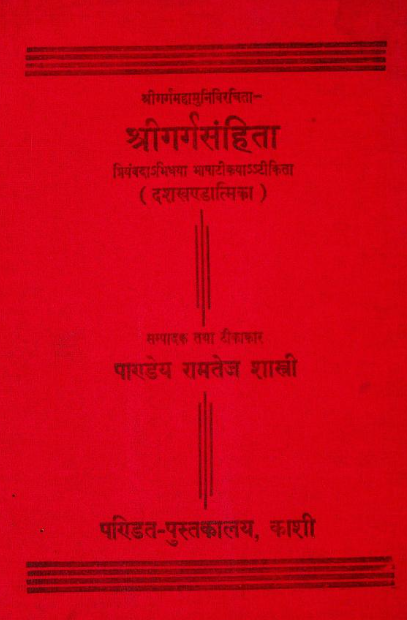Author: Shri Gargacharya
About the author:
Garg Rishi, also known as Garga Muni, is a highly respected sage in the Hindu tradition, renowned for his wisdom in both astrology (Jyotisha) and spiritual matters. His name is closely associated with the Yadava dynasty and, most notably, with Lord Krishna. Garg Rishi’s profound contributions to Vedic knowledge have made him a key figure in many sacred texts, including the Garg Sanhita, which offers deep insights into the life and teachings of Lord Krishna.
Lineage and Background
Garg Rishi belonged to the lineage of great sages and was the son of Bharadwaja and the grandson of Angirasa. As a prominent figure in the ancient Gotra system, the lineage of sage Garg is considered one of the important Brahminical lines in Hinduism. He is often described as a highly learned sage with expertise in the Vedic sciences, especially in astrology and astronomy.
His wisdom extended far beyond astrology, encompassing various aspects of Vedic philosophy and cosmology, earning him respect among kings and sages alike. Garg Rishi was known for his practical application of Vedic principles in matters of governance, dharma, and devotion.
Astrological Expertise and the Naming of Lord Krishna
Garg Rishi is perhaps most famous for his role in performing the naming ceremony (Namkaran) of Lord Krishna, which is recorded in the Srimad Bhagavatam. Invited by Nanda Maharaj, the foster father of Krishna, Garg Rishi performed the sacred ceremony in secret to protect the child from the wrath of King Kamsa. It was Garg Rishi who revealed key astrological details about Krishna’s future and his divine nature, referring to him as the incarnation of Lord Vishnu who would restore dharma and protect the righteous.
This event marks Garg Rishi’s pivotal contribution to Krishna’s life and to the larger narrative of Hindu scriptures, linking his astrological predictions with the divine mission of the Lord.
I have mentioned some details of the Astrological Aspect of Gargacharya from Garg Sanhita, Mahabharat and Bhagwat Purana in the following video:
Author of Garg Sanhita
Garg Rishi is also credited with the authorship of the Garg Sanhita, an ancient scripture that elaborates on the life, pastimes, and teachings of Lord Krishna. The text offers a detailed account of Krishna’s leelas, including his early years in Vrindavan, his battles with demons, his relationships with the Gopis, and his ultimate role as the preserver of dharma. Through Garg Sanhita, Garg Rishi emphasizes the importance of devotion (bhakti), love, and the eternal connection between the soul and the Supreme.
The Garg Sanhita serves as both a historical and spiritual guide, blending the narrative of Krishna’s life with deeper philosophical meanings that guide devotees on the path of bhakti and righteousness.
Garg Rishi’s Influence in Jyotisha (Vedic Astrology)
Garg Rishi’s contributions to the field of astrology are highly revered, with his name often cited in astrological texts as one of the foundational figures in Jyotisha. His deep understanding of planetary movements and their influence on human life made him a leading astrologer of his time, consulted by kings and sages alike.
His wisdom was not limited to celestial bodies but extended to the understanding of cosmic principles and their interaction with human destinies. Garg Rishi is often quoted for his precise predictions and his ability to link the cosmic order with the events on Earth.
Legacy and Influence
Garg Rishi’s legacy as both a sage and an astrologer has endured through the ages. His teachings on astrology continue to influence modern Vedic astrology, while his spiritual contributions through the Garg Sanhita have inspired countless devotees of Lord Krishna. His role in shaping the narrative of Krishna’s divine mission places him among the most venerated sages in Hindu tradition.
Garg Rishi’s emphasis on righteousness, devotion, and the understanding of cosmic principles through astrology and spirituality makes him a timeless figure whose wisdom remains relevant for seekers of knowledge, devotion, and liberation.
Conclusion
Garg Rishi, the great sage and astrologer, stands as an embodiment of Vedic wisdom and devotion. Through his association with Lord Krishna, his profound astrological insights, and his composition of the Garg Sanhita, he has left an indelible mark on Hindu spirituality. His teachings continue to guide devotees on their spiritual journey, emphasizing the importance of aligning with divine will and living a life rooted in dharma and devotion.






